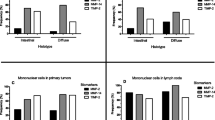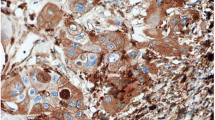Summary
Using monoclonal antibody 25 F 9, which reacts with a determinant of mature macrophages, the inflammatory infiltrate of 66 gastric carcinomas was evaluated using a counting grid. The ratio tumor cells/macrophages was determined for every tumor. For a threshold value of 5, carcinomas with a better prognosis, such as the intestinal type according to Lauré, the expanding type according to Ming and the differentiated carcinomas according to the WHO had a significantly smaller relative content of 25 F 9-positive macrophages (a minimum of P<0.05) than the diffuse type, infiltrative type, and undifferentiated carcinomas. Furthermore, the relative macrophage content tended to increase with the stage of carcinoma spread (P<0.1). The results suggested that 25 F 9-positive macrophages in gastric carcinoma are of greater significance in tumor spread than in any defensive reaction against the tumor.
Similar content being viewed by others
References
Allen C, Hogg N (1985) Monocytes and other infiltrating cells in human colorectal tumours identified by monoclonal antibodies. Immunology 55:289–299
Biondi A, Rossing TH, Bennett J, Todd RF III (1984) Surface membrane heterogeneity among human mononuclear phagocytes. J Immunol 132:1237–1243
Birbeck MSC, Carter RL (1972) Observations on the ultrastructure of two hamster lymphomas with particular reference to infiltrating macrophages. Int J Cancer 9:249–257
Black MM, Freeman C, Mork T, Harvel S, Cutler SJ (1971) Prognostic significance of microscopic structure of gastric carcinomas and their regional lymph nodes. Cancer 27:703–711
Bröcker E-B, Kolde G, Steinhausen D, Peters A, Macher E (1984) The pattern of the mononuclear infiltrate as a prognostic parameter in flat superficial spreading melanomas. J Cancer Res Clin Oncol 107:48–52
Bröcker E-B, Zwadlo G, Suter L, Brune M, Sorg C (1987) Infiltration of primary and metastatic melanomas with macrophages of the 25 F 9-positive phenotype. Cancer Immunol Immunother 25: (in press)
Brooks DA, Zola H, McNamara PJ, Bradley J, Bradstock KF, Hancock WW, Atkins RC (1983) Membrane antigens of human cells of the monocyte/macrophage lineage studied with monoclonal antibodies. Pathology 15:45–52
Dimitriu-Bona A, Burmester GR, Waters SJ, Winchester RJ (1983) Human mononuclear phagocyte differentiation antigens. 1. Patterns of antigenic expression on the surface of human monocytes and macrophages defined by monoclonal antibodies. J Immunol 130:145–152
Eccles SA, Alexander P (1974) Macrophage content of tumors in relation to metastatic spread and host immune reaction. Nature 250:667–669
Evans R, Duffy T, Cullen RT (1984) Tumor-associated macrophages stimulate the proliferation of murine tumor cells surviving treatment with the oncolytic cyclophosphamide analogue asta Z-7557: in vivo implications. Int J Cancer 34:883–890
Gauci CL (1976) The significance of the macrophage content of human tumours. In: Mathé G, Florentin I, Simmler MC (eds) Lymphocytes, macrophages, and cancer Springer Berlin Heidelberg New York, pp 122–130
Gauci CL, Alexander P (1975) The macrophage content of some tumours. Cancer Lett 1:29–32
Grüter Th, Heidl G, Grundmann E, Zwadlo G, Sorg C (1985) Immunhistochemische Untersuchungen des Makrophageninfiltrates in Magenkarzinomen. Verh Dtsch Ges Pathol 69:460
Heild G, Davaris P, Düchting, S, Jagoda MS, Bierhoff E, Krieg V, Grundmann E (1986) Zur Nachweisbarkeit des karzinoembryonalen Antigens (CEA) an Gefrier-und Paraffinschnitten von Magenkarzinomen. Verh Dtsch Ges Pathol 70:225–230
Hibbs Jb, Chapman H Jr, Weinberg JB (1978) The macrophage as an antineoplastic surveillance cell: biological perspecitves. J Reticuloendothel Soc 24:549–570
Hogg N, MacDonald M, Slusarenko M, Beverly PCL (1984) Monoclonal antibodies specific for human monocytes, granulocytes and endothelium. Immunology 53:753–767
Immich H (1974) Medizinische Statistik. Eine Einführungsvorlesung. Schattauer, Stuttgart New York
Inberg M, Laurén V, Vuori J, Viikari SJ (1973) Prognosis in intestinal-type and diffuse gastric carcinoma with special reference to the effort of the stromal reaction. Acta Chir Scand 139:273–278
Inokuchi K, Inutsuka S, Furusawa M (1967) Stroma reaction around tumor and metastasis and prognosis after curative gastrectomy for carcinoma of the stomach. Cancer 120:1924–1929
Keller R (1973) Cytostatic elimination of syngeneic rat tumor cells in vitro by nonspecifically activated macrophages. J Exp Med 138:625–644
Kopper L, Lapis K (1985) What's new in macrophage tumor cell interaction? Pathol Res Pract 179:652–655
Knowles DM, Tolidjian IB, Marboe C, D'Agati V, Grimes M, Chess L (1984) Monoclonal anti-human monocyte antibodies OKM 1 and OKM 5 possess distinctive tissue distributions inclunding differential reactivity with vascular endothelium. J Immunol 132:2170–2173
Lapis K, Kopper L, Timar J, van Hanh T, Hegedüs C (1981) Effect of macrophages on the growth of syn-and xenogeneic tumors. Arch Geschwulstforsch 51:475–479
Lasser A (1983) The mononuclear phagocyte system: a review. Hum Pathol 14:108–126
Lauder I, Waherne J, Stewart J, Sainsbury R (1977) Macrophage infiltration of breast tumors: a prospective study. J Clin Pathol 30:563–568
Laurén P (1965) The two histological main types of gastric carcinoma: diffuse and so-called intestinal-type carcinoma. An attempt at a histo-clinical classification. Acta Pathol Microbiol Scand 64:31–49
Mahoney KH, Fulton AM, Heppner GH (1983) Tumor-associated macrophages of mouse mammary tumors. II. Differential distribution of macrophages from metastatic and nonmetastatic tumors. J Immunol 131:2079–2085
Mantovani A, Giavazzi R, Polentaruti N, Spreafico F, Garattini S (1980) Divergent effects of macrophage toxins on growth of primary tumors and lung metastases in mice. Int J Cancer 25:617–620
Maruyama S, Naito T, Kakita H, Kishimoto S, Yamamura Y, Kishimoto T (1983) Preparation of a monoclonal antibody agains human monocyte lineage. J Clin Immunol 3:57–64
Mehrotra ML, Gupta IM, Khanna S, Vaidya MP (1978) Host response and tumor biological behavior in the two histological types of gastric carcinoma. Histopathology 2:373–382
Ming S-C (1977) Gastric carcinoma. A pathobiological classification. Cancer 39:2475–2485
Monafo WW, Krause GL, Medina JG (1962) Carcinoma of the stomach: morphological characteristics affecting survival. Arch Surg 85:754–763
Nacopoulou L, Azaris P, Papacharalampous N, Davaris P (1981) Prognostic significance of histological host response in cancer of the large bowel. Cancer 47:930–936
Nash JRG (1982) Macrophages in human tumours: an immunohistochemical study. J. Pathol 136:73–83
Nathan CF, Murray HW, Cohn ZA (1980) Current concepts: the macrophage as an effector cell. New Engl J Med 303:622–626
Neumann C, Sorg C (1983) Regulation of plasminogen activator secretion, interferon induction and proliferation in murine macrophages. Eur J Immunol 13:143–147
North RJ (1978) Opinions: the concept of the activated macrophage. J Immunol 121:806–816
Okada M, Kojima S, Murakami M, Fuchigami T, Yao T, Omae T, Iwashita A (1983) Human gastric carcinoma: prognosis in relation of macroscopic and microscopic features of the primary tumor. J Natl Cancer Inst 71:275–279
Oota K, Sobin LH (1977) Histological typing of gastric and oesophageal tumors. Int Histol Class of Tumours; 18. World Health Organization, Geneva
Pagnini CA, Rugge M (1985) Advanced gastric cancer and prognosis. Virchow's Arch (Pathol Anat) 406:213–221
Plytycz B, Pedersen A, Bogwald J, Seljelid R (1986) In vitro interactions of murine peritoneal macrophages and sarcoma cells. I. Promotion of tumor cell proliferation by macrophages. Virchows Arch (Cell Pathol) 50:285–292
Polverini PJ, Cotran RS, Gimbrone MA, Unanue ER (1977) Activated macrophages induce vascular proliferation. Nature 269:804–806
Radzun HJ, Parwaresch MR (1983) Differential immunohistochemical resolution of the human mononuclear phagocyte system. Cell Immunol 82:174–183
Raff HV, Picker LJ, Stobo JD (1980) Macrophage heterogeneity in man. A subpopulation of HLA-DR-bearing macrophages required for antigen-induced T-cell activation also contains stimulators for autologous-reactive T-cells. J Exp Med 152:581–593
Ribeiro MM, Sarmento JA, Simoes MA, Bastos J (1981) Prognostic significance of Laurén and Ming classifications and other pathologic parameters in gastric carcinoma. Cancer 47:780–784
Stemmermann GN, Brown C (1974) A survival study of intestinal and diffuse types of gastric carcinoma. Cancer 33:1190–1195
Stenzinger W, Brüggen J, Macher E, Sorg C (1983) Tumor angiogenic activity (TAA) production in vitro and growth in the nude mouse by human malignant melanoma. Eur J Cancer Clin Oncol 19 (5):649–656
Stosiek P, Varga A, Kasper M (1983) Untersuchungen zur immunologischen Bedeutung der entzündlichen Stromareaktion bösartiger Tumoren. Klin Wochenschr 61:157–162
Stosiek P, Kasper M, Varga A (1983) Prognoserelevante Befunde beim Magenkarzinom (Varianz-und diskriminanzanalytische Untersuchungen mit klinischen, morphologischen und immunologischen Merkmalen). Arch Geschwulstforsch 53:61–67
Stutman O (1975) Immunosuppression and malignancy. Adv Cancer Res 22:261–422
Svennevig J-L, Lövik M, Svaar H (1979) Isolation and characterization of lymphocytes and macrophages from solid, malignant human tumours. Int J Cancer 23:626–631
Svennevig J-L, Lunde OC, Holter J, Bjorgsvik D (1984) Lymphoid infiltration and prognosis in colorectal carcinoma. Br J Cancer 49:375–377
Talle MA, Rao PE, Westberg E, Allegar N, Makowski M, Mittler RS, Goldstein G Patterns of antigenic expression on human monocytes as defined by monoclonal antibodies. Cell Immunol 78:83–99
Ting CC, Rodriguez D (1980) Switching on the macrophage-mediated suppressor mechanism by tumor cells to evade host immune surveillance. Proc Natl Acad Sci 77:4265–4269
Todd RF III, Nadler LM, Schlossman SF (1983) Antigens on human monocytes identified by monoclonal antibodies. J Immunol 126:1435–1442
Ugolini V, Nunez G, Smith RG, Stastny P, Capra JD (1980) Initial characterization of monoclonal antibodies against human monocytes. Proc Natl Acad Sci USA (Immunol) 77:6764–6768
UICC (1985) TNM Atlas, Illustrierter Leitfaden zur TNM/pTNM-Klassifikation maligner Tumoren. Hrsg. B. Spiessl, P. Hermanek, O. Scheibe, G. Wagner. Springer, Berlin Heidelberg NY Tokyo
Vollmer E, Grundmann E, Nienhaus H, Mellin W, Zwadlo G (1985) Macrophages and proliferation in mammary carcinoma and mastopathia. An immunohistochemical study. Verh Dtsch Ges Pathol 69:135–142
Watanabe H, Enjoji M, Imal T (1976) Gastric carcinoma with lymphoid stroma. Cancer 38:232–243
Weibel ER (1967) Structure in space and its appearance in sections. In: Elias H (ed) Stereology. Springer, New York
Wood GW, Collahon KA (1979) Detection and quantification of macrophage infiltration into primary human tumors with the use of cell-surface markers. J Natl Cancer Inst 59:1081–1087
Zwaldo G, Bröcker E-B, von Bassewitz D-B, Feige U, Sorg C (1985) A monoclonal antibody to a differentiation antigen present on mature human macrophages and absent from monocytes. J Immunol 134:1487–1497
Author information
Authors and Affiliations
Additional information
Dedicated to Professor Dr.E. Grundmann (Münster, FRG) on the occasion of his 65th birthday
Supported by the Deutsche Forschungsgemeinschaft (AZ Gr 711/2-1)
Rights and permissions
About this article
Cite this article
Heidl, G., Davaris, P., Zwadlo, G. et al. Association of macrophages detected with monoclonal antibody 25 F 9 with progression and pathobiological classification of gastric carcinoma. J Cancer Res Clin Oncol 113, 567–572 (1987). https://doi.org/10.1007/BF00390867
Received:
Accepted:
Issue Date:
DOI: https://doi.org/10.1007/BF00390867




